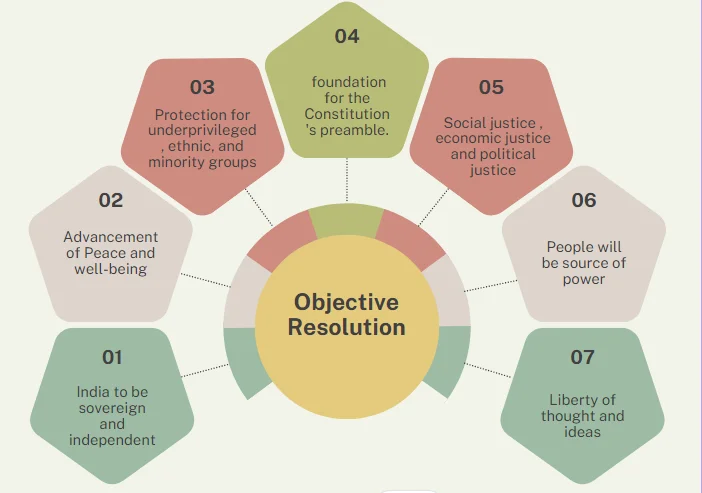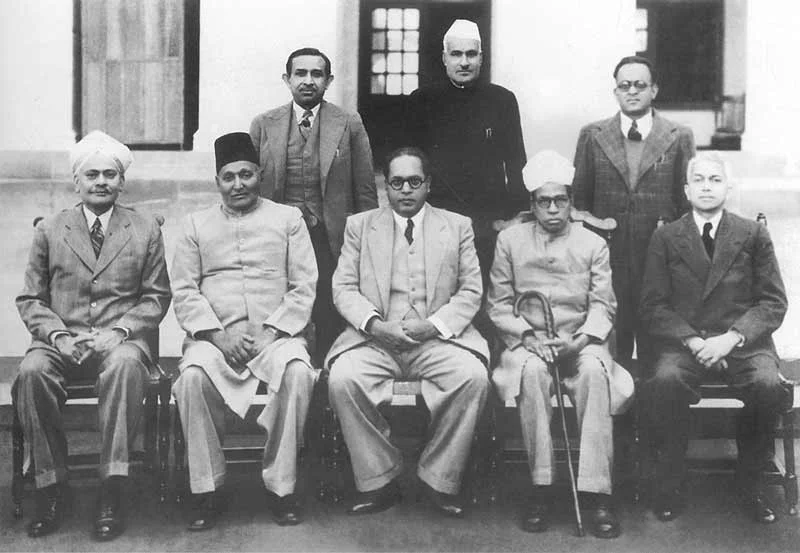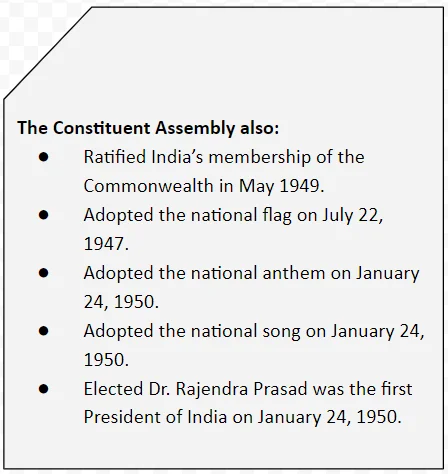The Constituent Assembly of India was tasked with framing the country’s Constitution, beginning its work in December 1946. Key figures like Jawaharlal Nehru and Dr. B.R. Ambedkar played crucial roles in shaping the fundamental principles and structure of governance. Through a series of committees and rigorous debates, the Assembly laid down the foundation for a sovereign and democratic India.
Overview of the Role and Workings of India’s Constituent Assembly
Objective Resolution in Constituent Assembly
On December 13, 1946, Jawaharlal Nehru moved the historic ‘Objectives Resolution’ in the Assembly. It laid down the fundamentals and philosophy of the Constitutional structure. It read:
- This Constituent Assembly declares its firm and solemn resolve to proclaim India as an Independent Sovereign Republic and to draw up for her future governance a Constitution.
- The territories that had comprised British India, the territories that have now formed the Indian States, and such other parts of India as are outside India and the States as well as other territories as are willing to be constituted into the independent sovereign India, shall be a Union of them all.
- The territories, whether with their present boundaries or with such others as may be determined by the Constituent Assembly and thereafter according to the law of the Constitution, shall possess and retain the status of autonomous units together with residuary powers and exercise all powers and functions of Government and administration save and except such powers and functions as are vested in or assigned to the Union or as are inherent or implied in the Union or resulting therefrom.
- All power and authority of the sovereign independent India, its constituent parts, and organs of Government will be derived from the people;
- It shall be guaranteed and secured to all the people of India justice, social, economic, and political; equality of status of opportunity, and before the law; freedom of thought, expression, belief, faith, worship, vocation, association, and action, subject to the law and public morality; and
- Adequate safeguards shall be provided for minorities, backward and tribal areas, depressed and other backward classes.
- The integrity of the territory of the Republic and its sovereign rights on land, sea, and air are to be maintained according to justice and the law of civilised nations;
- India as an ancient land attains its rightful and honoured place in the world and makes its full and willing contribution to the promotion of world peace and the welfare of mankind.

This Resolution was unanimously adopted by the Assembly on January 22, 1947 and it influenced the eventual shaping of the Constitution through all its subsequent stages. The modified version forms the Preamble of the present Constitution.
Enroll now for UPSC Online Course
Committees of the Constituent Assembly
The Constituent Assembly appointed several committees to deal with different Constitutional-making tasks. Out of these, eight were major, and the others were minor.
The names of these committees and their Chairman are given below
Major Committees
- Union Powers Committee – Jawaharlal Nehru
- Union Constitution Committee -Jawaharlal Nehru
- States Committee (Committee for Negotiating with States) – Jawaharlal Nehru
- Drafting Committee – Dr. B.R. Ambedkar
- Provincial Constitution Committee -Sardar Patel
- Advisory Committee on Fundamental Rights, Minorities and Tribal and Excluded Areas – Sardar Patel. This committee had the following five sub-committees:
- Fundamental Rights Sub-Committee – J.B. Kripalani
- Minorities Sub-Committee – H.C. Mukherjee
- North-East Frontier Tribal Areas and Assam Excluded & Partially Excluded Areas Sub-Committee –Gopinath Bardoloi
- Excluded and Partially Excluded Areas (other than those in Assam) Sub-Committee – A.V. Thakkar
- North-West Frontier Tribal Areas Sub-Committee
- Steering Committee – Dr. Rajendra Prasad
- Rules of Procedure Committee- Dr. Rajendra Prasad
Minor Committees
- Finance and Staff Committee – Dr. Rajendra Prasad
- Credentials Committee – Alladi Krishnaswami Ayyar
- House Committee – B. Pattabhi Sitaramayya
- Committee on Chief Commissioners’ Provinces – B. Pattabhi Sitaramayya
- Expert Committee on the Financial Provisions of the Union Constitution –Nalini Ranjan Sarkar (Not an Assembly Member)
- Linguistic Provinces Commission – S.K. Dar (Not an Assembly Member)
- Special Committee to Examine the Draft Constitution – Jawaharlal Nehru
- Press Gallery Committee – Usha Nath Sen
- Ad-hoc Committee on Citizenship – S. Varadachari (Not an Assembly Member)
- Order of Business Committee – Dr. K.M. Munshi
- Ad-hoc Committee on the National Flag – Dr. Rajendra Prasad
- Committee on the Functions of the Constituent Assembly – G.V. Mavalankar
- Ad-hoc Committee on the Supreme Court – S. Varadachari (Not an Assembly Member)
Drafting Committee
- The Drafting Committee was set up on August 29, 1947. This was the significant committee that was entrusted with the task of preparing a draft of the new Constitution. It consisted of:

-
- Dr. B.R. Ambedkar as the Chairman.
- N. Gopalaswamy Ayyangar
- Alladi Krishnaswamy Ayyar
- Dr. K.M. Munshi
- Syed Mohammad Saadullah
- N. Madhava Rau (He replaced B.L. Mitter, who resigned because of ill-health)
- T.T. Krishnamachari (He replaced D.P. Khaitan, who died in 1948)
- Publication of the First Draft: The Drafting Committee, after taking into consideration the proposals of the various committees, prepared the first draft of the Constitution of India, which was published in February, 1948.
- Public Discussion and Second Draft: The people of India were given eight months to discuss the draft and propose amendments.
- In light of the public comments, criticisms, and suggestions, the Drafting Committee prepared a second draft, which was published in October 1948.
- Efficiency Drafting Committee: The Drafting Committee took less than six months to prepare its draft. In all, it sat only for 141 days.
Time spent by countries to frame their Constitution
| Country | Time |
| India | The Constituent Assembly had 11 sessions over two years, 11 months and 18 days. The Constitution-makers had gone through the Constitutions of about 60 countries, and the Draft Constitution was considered for 114 days. The total expenditure incurred on making the Constitution amounted to ₹64 lakh |
| USA | Less than four months |
| Canada | 2.6 years; |
| Australia | 9 years; |
| South Africa | 1 year |

Final Drafting and enacting of the Indian Constitution
First reading: Dr. B.R. Ambedkar introduced the final draft of the Constitution in the Assembly on November 4, 1948. The Assembly had a general discussion on it for five days (till November 9, 1948).

- Second Reading: The clause-by-clause consideration and reading started on November 15, 1948, and ended on October 17, 1949.
- During this stage, as many as 7653 amendments were proposed and 2473 were actually discussed in the Assembly.
- Third reading: On November 14, 1949, Dr. B.R. Ambedkar moved a motion–‘the Constitution as settled by the Assembly be passed’.
- Adoption and Signing of the Constitution: The motion on Draft Constitution was declared as passed on November 26, 1949, and received the signatures of the members and the president.
- Indians enacted and gave to themselves this Constitution. However, out of a total of 299 members of the Assembly, only 284 were actually present on that day and signed the Constitution.
- Role of Dr. B.R. Ambedkar: The Preamble was enacted after the entire Constitution was already enacted. Dr. B.R. Ambedkar, the then Law Minister, piloted the Draft Constitution in the Assembly.
Enroll now for UPSC Online Course
- Structure of the Adopted Constitution: The Constitution which was adopted on November 26, 1949, contained a Preamble, 395 Articles, and 8 Schedules.
| Must Read | |
| Current Affairs | Editorial Analysis |
| Upsc Notes | Upsc Blogs |
| NCERT Notes | Free Main Answer Writing |
Conclusion
After nearly three years of deliberation, the Constituent Assembly adopted the Indian Constitution on November 26, 1949. This document, reflecting the collective vision and values of the Assembly, established the legal framework for an independent India. The Constitution remains a cornerstone of the country’s democracy, guiding its governance and upholding the rights of its citizens.
Sign up for the PWOnlyIAS Online Course by Physics Wallah and start your journey to IAS success today!
| Related Articles | |
| Jawaharlal Nehru Biography, Education, Wife, Books, Death, History | FUNDAMENTAL RIGHTS (UDAAN) |
| Preamble of the Indian Constitution | Constituent Assembly of India |

 GS Foundation
GS Foundation Optional Course
Optional Course Combo Courses
Combo Courses Degree Program
Degree Program









